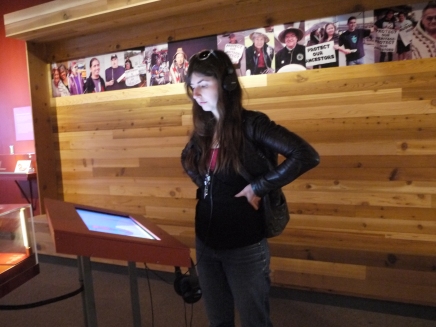Last week I had the pleasure of visiting the new c̓əsnaʔəm, the city before the city exhibition at the Museum of Vancouver. It provides an unprecedented look into the past and present of the Musqueam people, who have lived in what is now Vancouver for thousands of years. The project was developed with advisors from Musqueam First Nation, and the words and voices of their community are central to every aspect of the exhibit. This is a step forward in the effort to raise awareness about Aboriginal culture, and its exclusion from the public eye. In the words of Musqueam cultural advisor Larry Grant, the goal of the c̓əsnaʔəm project is “to highlight the community’s role in shaping the City of Vancouver.”
Yet this laudable aim is not the only groundbreaking aspect of the exhibition. What I find equally fascinating about the c̓əsnaʔəm project is the collaborative, cross-institutional approach to its development and presentation. In fact, the exhibition is currently being hosted at no fewer than three sites in the city: the Museum of Vancouver, the Museum of Anthropology at UBC, and the Musqueam Cultural Education Resource Centre and Gallery. These three institutions worked together to create the overarching vision of c̓əsnaʔəm and present three distinct but related exhibitions in each of their spaces.
Having already visited its counterpart at the Museum of Anthropology back in February, I was able to make connections between the two exhibits that made my M.O.V. experience more meaningful. I was first introduced to the concept of content “layers” in museums several years ago while working at a well-known palace in the U.K. The basic goal of layers is to provide visitors with multiple levels of information about an object, allowing them to choose how deeply they want to engage with the content. For example, the title, origin, and date info next to an object might be the first layer, followed by a paragraph of panel text, followed by an audio recording of the curator’s insights, followed by an app or link to online content, et cetera. The c̓əsnaʔəm project takes the idea of layers to a new level (no pun intended); each exhibition can be enjoyed and understood independently, or as part of a broader city-wide, multi-day experience.
Imagine cross-institutional exhibits that transcend regional or national boundaries! Museum visitors in different parts of the world could experience the same overarching vision simultaneously, within the context of their own space and culture. Perhaps the collaborative approach of c̓əsnaʔəm is a glimpse into the future of museum curation and community engagement.

